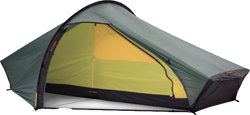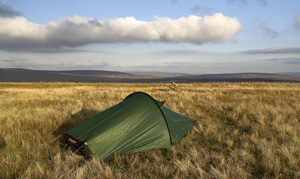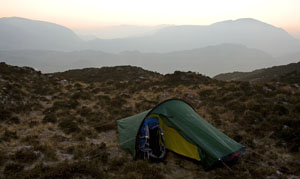
 |
Hilleberg description: The Akto is ideal any time you need the lightest weight, all condition solo tent. It is especially good for long trips of any kind, in any season, where light weight is a very high priority. And while it was not designed for extreme above tree line use, the Akto has proven itself on extended polar expeditions, and so will stand up well to all conditions. This is, in part, because of the Akto's roomy configuration, it will easily accommodate you and your gear and because of its remarkably strong Kerlon 1200 outer tent fabric. Its single pole Tunnel Tent construction, very light (yet very strong) Kerlon 1200 and 9 mm pole make it best suited for mobile trips, where you pitch and take down your tent every day. Hilleberg SpecsTotal Weight: 1.5kg / Inner height: 90cms / Inner length: 2.2m |
I bought the Akto for my first venture into solo backpacking, based on numerous reports of excellent quality and 4-season capability (the other contender was the lighter ~1kg Terra Nova Laser Competition). The Akto seemed a pretty good tradeoff between weight and robustness/stability, and at 1.5kg is the maximum I would consider for a solo tent.
I checked the weight myself: as supplied it weighs 1.49kg including the stuffbag, pegs + peg-bag and pole repair sleeve, but excluding the spare pole section. On first inspection the quality of construction and materials were immediately reassuring.
Update: I have sold the Akto and bought the Terra Nova Laser Competition.

I've seen so many photos and forum threads about the Akto that I felt I knew it already, and I did a quick trial pitch in the back garden with no surprises or difficulties - except perhaps the pegs. I've only ever used the standard J-shaped pegs (like a walking-stick shape) which is obvious: the curved-over bit secures the eyelets and guylines firmly down and they can't come off. The Akto straight pegs only have a tiny cutout near the top end, a small movement and the rings / guylines can flirt off even when optimally pegged at about 45 degrees. Anyway it didn't matter because I decided to use a subset of the Voyager titanium J-pegs and will probably continue using those.
The guyline structure is excellent: at each corner a guyline is threaded through the material to form a triangle with the peg at one vertex. The four triangles of cord are splayed out at a wide angle to give maximum support to the tent structure and each is adjustable by a sliding tensioner. Two further long guylines add support at the front and back of the tent in the plane of the pole.
The internal space was surprisingly long: I'm 5ft 7½ins and had lots of room to spare, considerably more than I need. This is great for tall people but rather annoying for me, it could be quite a bit shorter and reduce the weight!.
By contrast the headroom was less than one would expect given the length, only just enough for me at the highest point and a potential problem for anyone taller. I had to sit precisely at the centre and keep my head very still to avoid it touching.
Despite the profusion of Aktos out there and online discussions about them, there is still much about this tent that is poorly understood. One fundamental point came to light when two people pitched their Aktos side by side, and noticed that one was very significantly taller than the other but less wide, a result of the different curvatures of the poles. This is determined by the length of the transverse horizontal cord directly below the pole and parallel to it, which was different for the two tents. A forum thread was posted to discuss headroom in relation to this point and several owners measured their cords, in the meantime Hilleberg were emailed for their 'correct' length.
I did my own measurement: I pitched the outer by itself and fully tightened the adjustment strap next to the pole cup, then measured the length of cord between the black plastic rings that hold it - it was 164cm (as a further check the total horizontal length including the black rings and attachment tabs, i.e. green-nylon to green-nylon, was 170cm). An email eventually arrived from Hilleberg giving an approximate cord length of about 165cm, making mine pretty well spot-on, compared with the longest cord measured which was 182cm resulting in a lower height.
Then I attached the inner and measured the available height inside, as best I could judge it was 91cm. While sitting inside, I tried pulling the loose strand of the cord inwards a bit (it does slide quite easily) but I'm not sure what it achieved, it didn't seem to make any noticeable difference.
Both outer and inner doors can be rolled up and secured in the open position with loops and toggles. The inner door toggle worked very effectively, but the outer door toggle is positioned well off-centre near the lower end, and the high end kept unfurling and dropping down. This could be dangerous when using a stove in the porch. There must be a knack to the way it is rolled, more practice and experimentation required here.
When the outer door is zipped down and closed, the bottom edge is slack and billows in and out in the wind. This too would be a problem when using a stove in the porch with the door closed in windy conditions, and I would need to find a method of holding it back securely, maybe a small rock.
I first used the Akto on this 2-day backpack in early September. On this trip there was merely a pleasant breeze blowing which didn't test the tent in any way, ideal camping weather really.
There were two major points I noted:

Firstly the inner: I'm very fussy about ventilation of the inner and our TN Voyager gets it exactly right, giving us total control: a fixed triangle of mesh at the smaller rear end and double doors at the other, one mesh and one solid. The percentage of mesh at the larger door end can be varied from 0 to 100% to suit the conditions and obtain the desired air movement, we normally have the solid door folded right back to give 100% mesh. In the Akto there is just one small triangle of mesh in the upper half of the door, and that's it. Even this can be closed off with a solid flap attached by Velcro, but I regard it as an absolute minimum requirement. The problem is that the ventilation can't be increased except by partly unzipping the door itself, which is not really an option on warm summer nights because of midges, and it wouldn't work very well anyway because both air inlet points would be on the same side and not create an airflow.
I later had a custom modification done to fix this problem, described below.
Variable ventilation of the outer is achieved by zipped curved vents in the inward sloping walls at either end, and I would agree with the general consensus that these should be fully open in most conditions, and perhaps just partly open on the windward side in driving rain. In snow conditions when spindrift is likely they will need to be closed.
The second point is a dilemma: whether to detach the inner in the morning for packing, or leave it attached and collapse the tent as one. On most mornings the inside of the fly will be wet to some extent regardless of ventilation. On this trip of 2 days / 1 night it didn't matter, I collapsed the whole soggy thing as one, but for trips of two or more nights Hilleberg recommend detaching the inner if the fly is wet, which I would certainly agree with in principle, but it's not that simple'
There have been reports that when pitching the fly first and then attaching the inner, it is possible that the inner toggles will not reach the loops, at least initially. If this happens, you have to go out and slacken some of the pegs and try again, repeating until they reach, then retighten all the pegs at the end. It may be that when pitched together, the pre-attached inner constrains the extent of the pegging points. At any rate this performance in a cramped awkward position is said to be a right pain, especially on wet ground, and most people leave them joined together and tolerate the soggy inner.

This trial was on Round Hill in the North Pennines, and once again there was a good breeze blowing outside but it was impossible to get air movement without the door open, and then it tended to produce an uncomfortable localised swirl of air in one place rather than a slow steady throughput as we get in the Voyager. Overnight I left the two zips undone a few inches at the door corner to let a little bit of air in, which helped slightly but not much.
In the morning the mist was down and it was quite chilly, though not very cold, and I noticed that the roof of the inner and the outer shell of the sleeping bag were very slightly moist. This virtually never happens with the Voyager with two of us in it, the only exceptions being on very calm cold nights and even then it's barely noticeable, and I was more convinced than ever that mesh at both ends is the only way to maintain a constant steady exchange of air. The single small mesh panel of the Akto cannot possibly achieve this.

When pitched there are two vertical walls a few inches high at the head and foot ends of the inner: I had these replaced by mozzie mesh to give a ventilation panel at both ends. In the photo the open outer vent can be seen through the mesh panel.
The mod was done very speedily by Scottish Mountain Gear and the work is excellent, so good I can't tell that it wasn't designed like that in the first place. Custom mods sometimes have a 'grafted-on' appearance but not here, I had a pristine ventilated Akto MkII and I was sure it would be a big improvement for me.
On this trip the conditions were not cold enough to give a really good condensation test but the initial results were very encouraging.
I'm happy to report that the mod worked very well, as expected really since the idea came from our Voyager inner which has always been excellent. For the test I kept the outer flysheet vents unzipped as usual and the inner door closed. I also closed off the standard triangular mesh panel in the door: the physics involved is not obvious (to me): having a side panel open as well could improve the ventilation due to a greater area of mesh, or worsen it by interfering with the end-to-end flow.
Conditions:- very little wind, mild evening and night well above freezing.

After an hour or two the improvement was readily apparent even without a significant breeze: no feeling of stuffiness and the exchange of air was clearly working sufficiently. In the morning the inside of the inner was completely dry. Curiously the underside of the flysheet was only slightly moist compared to the sopping wetness on the Cross Fell trip, but that must be a coincidence I would think - maybe it was a pretty dry airstream today and it was milder than the previous trip. I can't see how a better ventilated inner could help with reducing condensation under the flysheet, but what do I know'
Conditions:- a good breeze blowing, misty and drizzling much of the evening with a brief spell of proper rain, dry overnight. Similar mild temperature to the previous night.
No surprise with the ventilation here: it was of course even more efficient with the help of a good breeze, but as we learned from the Voyager, the mesh cuts down the perceived flow very effectively and it didn't feel at all draughty. I concentrated on the windward end of the tent to see if any drizzle and rain could penetrate the mesh via the open vents, but there were no problems. The overhanging ends of the Akto flysheet shield the vents and inner well in most conditions, but in the event of a strong wind driving the rain at a shallow angle, the outer vent on the windward side could be zipped part way up to stop any ingress. In fact this is what I did just in case the weather worsened overnight.
In the morning the inside of the inner was again dry, a very pleasing result with the increased moisture in the air. Very curiously, the underside of the flysheet was again only slightly moist which was really surprising, though I still suspect that it's nothing to do with the new mesh panels.
Verdict: I'm really pleased with this modification so far, the inner ventilation is vastly better. There was no trace of moisture in the inner on either morning of this trip, but I'll post an update when I've given it a more demanding test on a colder night.

Conditions:- light breeze, temperature below freezing throughout the night and morning. Initially in the evening the air was quite moist judging by the thick frost on the grass and the hazy views, but it became drier during the night with a thin frost and clear sky by dawn.
On this pitch I used the stove in the porch to boil some water for a hot drink, a very quick operation but of course it did briefly add a lot of water vapour to the air. Although the mesh panels improved the ventilation very well as expected, there was still a disappointing amount of condensation inside the inner for the rest of the evening, despite having the door partly open as well. To give some idea of the amount, the inner roof felt like a well steamed-up window but not enough to drip when I patted it. The condensation was still there as I closed up the tent for the night, and as I stretched out I noticed that the foot of the sleeping bag was almost making contact with the sloping inner, so I draped my waterproof over it as insurance against soggy down.
I can only compare this with our TN Voyager: in winter we have boiled a lot more water in the porch in similar and colder conditions, with the porch briefly resembling a turkish bath, but never had a trace of condensation in the inner. I strongly suspect this is largely due to the nature of the airflow in the Voyager which is much easier to visualise than the Akto: it is simply rear-to-front, which always moves water vapour away from the inner and out the door.
I was keen to see how the situation developed overnight, but unfortunately the weather conditions had changed markedly by morning. I was hoping to assess the condensation effect under near-constant conditions for a whole evening and night, but the air became a lot drier which prejudices the results. At dawn the inner was bone dry and there was very little moisture inside the flysheet, no doubt attributable to the drier air generally. Nevertheless it showed that a condensation-free inner was possible overnight in temperatures below freezing, at least in those dry conditions.
Once I had the mesh panel modification done, I was pleased with the overall performance and comfort of the tent on the first few undemanding trips. It felt solid for a one-pole tent and the excellent guyline arrangement would be reassuring in windy conditions.
As noted above, in cold damp conditions condensation inside the inner could be a significant problem even with all vents open, especially when cooking in the porch.
With the advent of very light solo tents like the 3-season ~1kg TN Lasercomp, I feel that Hilleberg may come under pressure to reduce the weight a little without compromising performance or durability, maintaining true 4-season confidence. Instinctively I think it could be trimmed to the 1.3kg mark without damage. I noted in a blog comment that tents should ideally be offered in different lengths, certainly in my case at least a foot could be hacked off the length and save a very useful amount of weight.
Regarding the ventilation of the inner, one reader has explained an alternative view whereby internal condensation is eliminated by keeping both the flysheet vents and inner flap closed, relying on a temperature differential between the breathable inner and the outside. I can't comment on the efficacy of this idea, but a closed unventilated inner would be intolerable to me regardless of any condensation issues, I want some throughput of fresh air for its own sake.